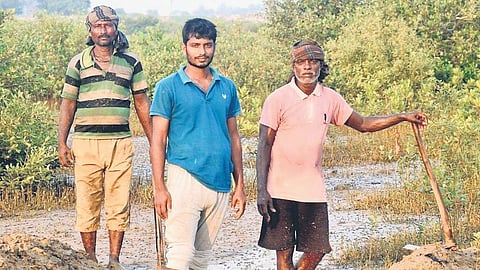

Planted in black grow bags, several rows of dark green saplings are neatly arranged within bunds (a small barrier/wall to prevent flooding) on the Astaranga beach in Puri district of Odisha. But they are not your regular house plants. These are several species of mangrove plants that 24-year-old environmentalist Soumya Ranjan Biswal has been voluntarily growing intending to regenerate the mangrove forests along the 18-km-long beach stretch. Locally called Rai, Harakancha, Sundari, Bani, Guan and Keruan, these plants are integral to the coastal habitat and livelihood of local fishermen.
“The most important benefit of mangroves is that they act as natural barriers during cyclones which are common in this part of the country besides rising tides,” says Biswal who has been raising the mangroves near the stretch of Devi river mouth—an Olive Ridley (an endangered turtle species) nesting site—with the help of the local community since last year. Mangroves make up less than one percent of all tropical forests worldwide. According to the India State of Forest Report 2019, India’s mangrove cover extends over 4,975 sq km, an increase of 54 sq km compared to the previous assessment. For instance, the mangrove cover in Gujarat has increased by 37 sq km, which is the highest expansion recorded in the country.
But there has been a steady decline in the number of mangrove plants in this coastal stretch in Odisha over the years due to several reasons, says the young environmentalist who has roped in 10 villagers of Astaranga to plant the saplings and maintain them around the year. “We are doing this voluntarily because our livelihood depends on the sea and the habitat around it. Besides, these plants will grow up to provide a habitat for both avian and marine lives,” says Biswal who belongs to a fisherman family and has been witness to the Olive Ridley nesting, degradation of the mangrove forests and turtle habitat since his childhood. It was after his bachelor’s degree from Nimapara Autonomous College in Puri district that he decided to form Odisha Paryavaran Sanrakshan Abhiyan (OPSA) to protect wildlife, mangroves and Olive Ridley turtles.
While he has a stock of 10,000 saplings now, his team will collect seeds from existing forests next month. A group of youth and fishermen support them voluntarily in growing the saplings from seeds and planting them in areas denuded of mangroves, says Biswal who was one among the United Nation’s 17 young climate leaders from India in September 2021. Three years back, he and his friend Dilip Kumar Biswal undertook a 1,200-km-long arduous cycle journey in Odisha, dressed as Olive Ridleys, to create awareness about protecting the endangered turtles.
The reat to ecosystem
✥ Mangroves in Odisha are threatened due to the high density of population in the state
✥ Land diverted towards agriculture and prawn farming
✥ It’s degenerated due to land encroachment